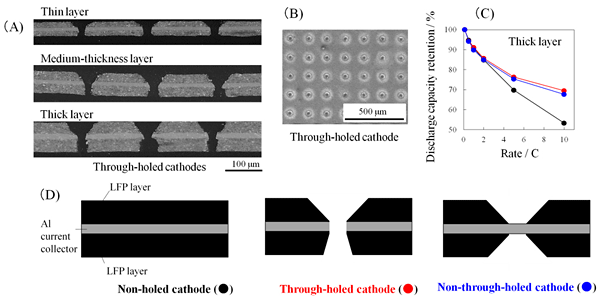Without any doubt, lithium ion batteries (LIBs) have extensively promoted the spread of mobile devices such as smartphones, tablet computers and digital cameras, and the development of electric vehicles (EV). It is expected that the next-generation LIBs should have higher capacity to extend a use time of mobile devices and a driving distance of EV. However, in order to establish our more convenient daily life with LIBs, LIBs which can keep high capacities even at high-rate discharge condition (at high current densities) along with high gravimetric and volumetric charging/discharging capacities should be improved. The realization of high charging/discharging rate performance enables fast charging in EV and mobile devices (and therefore reducing charging time) and the spread of usage of the LIBs as power storage devices for photovoltaic power and wind power generation systems, in which out-put voltage and current are changed in the wide range depending on the weather, and back-up power supplies that have to supply a required power immediately when local supply systems suddenly go down.
Holing of lithium iron phosphate (LiFePO4, LFP) cathodes with a pico-second pulsed laser (Figs. 1(A) and (B)), in which the average hole diameter and hole opening rate were 20-30 µm and 1-2%, respectively, enabled to retain the high-rate discharging performance even in the LFP cathodes composed of the having the LFP layer with the thickness of over 40 µm on an aluminum current collector. The conventional and flat LFP cathode exhibited the degradation of discharge retention at the high-rate discharge because of the low utilization of LFP materials in the case of the thick cathode layer. On the other hand, in the case of “through-holed” and “non-through-holed” LFP cathodes (Fig. 1(D)), there can be a more efficient insertion/deinsertion of Li+ ions to/from the LFP materials through the holes formed in the LFP layer, resulting in retaining the high-rate charging/discharging performance even in thick LFP cathodes (Fig. 1 (C)). The electrochemical impedance spectroscopy analysis confirmed that the formation of through-holes in the thick LFP layer is significantly effective to improve the high-rate discharging performance as a result of the decreased charge-transfer resistance of the LFP discharge process. The decrease in the charge-transfer resistance results from the increase in the area available in the LFP discharge process because the sidewalls of the holes can also take part in the Li+ ion transfer during the discharge process.
